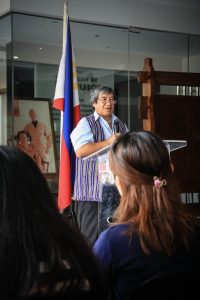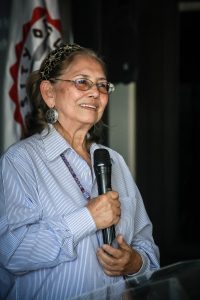As part of the Luzon Culture & Arts Festival project of the University of Baguio Alumni Foundation Inc., lectures on indigenous healing rituals and peace-keeping approaches in the Cordillera region were held at the UB Centennial Hall on April 26-27.
Benguet’s healing rituals
Prof. Isikias Picpican, the former curator and archivist of the SLU Museum of Arts and Cultures, presented the healing rituals and practices of Benguet on April 26. His talk explored the worldview of the Benguet people which revolves around the realm and existence of gods and spirits.
practices of Benguet on April 26. His talk explored the worldview of the Benguet people which revolves around the realm and existence of gods and spirits.
“In Benguet, the gods and goddesses are believed to be responsible for what is happening here on earth, and the Benguet people’s healing rituals are anchored on such belief,” he said.
The gamut of the healing rituals is extensive – from conception, birthing and delivery to the child’s first haircut, first tooth extraction, first menstruation (for girls), circumcision (for boys) and naming. The range likewise includes courtship, marriage and fertility ceremonies. It also covers death and life crisis rituals as well as festivity and community well-being rites.
Each ritual is carried out according to purpose – to cure an ailment, to ward off ill luck and natural calamities, to ensure bountiful harvest and favorable weather, or to mark a major phase in one’s life cycle.
Indigenous medicines
To the Igorot people, physical discomforts can either be due to natural factors or spirit-related afflictions brought about by one’s breach of social relations with the spirits or deities, Prof. Picpican noted. From such viewpoint, when herbal remedies become unsuccessful, the ritual practitioners are consulted, he said.
“Folk medicine is associated with the religious, economic and social systems [of the people], and it can be found in the plant lore, the animistic beliefs and the rudimentary medical techniques and faith healing that are characteristically prevalent in [indigenous] communities.”
Bontoc’s peace-keeping approaches
Cordilleran anthropologist Dr. June Chayapan Prill-Brett delivered a lecture on the indigenous peace-keeping approaches of the Bontok Igorot on April 27.
 In her lecture, she explained how the ato or ator plays a central role in the political, social, economic and religious decision-making of a particular ili or village. Reminiscent of England’s Stonehenge in structure, the ato/ator, among its functions, is where gatherings and conversations among the members of the community take place usually to settle disputes.
In her lecture, she explained how the ato or ator plays a central role in the political, social, economic and religious decision-making of a particular ili or village. Reminiscent of England’s Stonehenge in structure, the ato/ator, among its functions, is where gatherings and conversations among the members of the community take place usually to settle disputes.
The Igorot people have high regard for the elders, such that the council of elders is at the lead in decision-making whenever the ili is faced with problems that affect the whole village, remarked Dr. Prill-Brett. Decisions are arrived at by consensus, and the community’s ethical values serve as guidelines in the administration of justice, according to her.
For two villages that are in conflict against one another, Dr. Prill-Brett explained the pechen is used. It is a bilateral peace-making contract involving two independent villages that agree to forge a peace pact to end hostilities.
The role of women in peace-keeping in Bontoc was also underscored in Dr. Prill-Brett’s talk. The Bontoc Women Brigade, an organized group of elderly women aged 52 to 80, helps keep peace and order at night. Every night at 10 o’clock, they patrol the streets to help implement the curfew and liquor ban. The women warn bar establishments on their first round that the bar should be closed and that drinking should have stopped when they return from their first round.
The Luzon Culture & Arts Festival project is funded by the National Commission for Culture and the Arts. – Ronalyn T. Banaken -MAP

